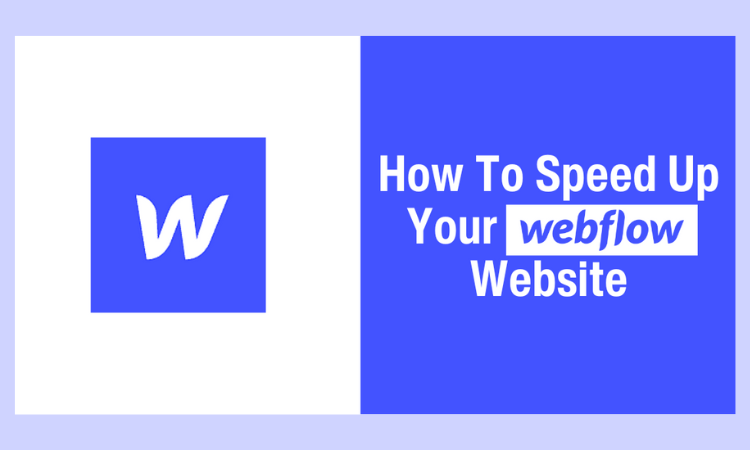Introduction
In today’s fast-paced digital world, a slow-loading website can be detrimental to your online presence. Users expect instant access to information, and if your Webflow website doesn’t deliver, they’ll quickly bounce off to competitors. Website speed is a crucial factor that affects user experience, search engine rankings, and overall conversions. In this comprehensive guide, we’ll dive deep into the world of Webflow speed optimization, exploring actionable techniques and best practices to supercharge your website’s performance.
Webflow Speed Optimization: Understanding the Importance
Before we delve into the how-to aspect, let’s first understand why website speed optimization matters. Faster websites provide a superior user experience, leading to increased engagement and longer sessions. Moreover, search engines like Google consider website speed as one of their ranking factors, so a slow website could negatively impact your SEO efforts.
Analyzing Your Webflow Website’s Current Performance
To optimize your Webflow website’s speed effectively, you must begin with a thorough analysis of its current performance. Several online tools, such as Google PageSpeed Insights and GTmetrix, can help you evaluate your website’s loading speed and identify areas for improvement.
Embracing Responsive Web Design
Your website will easily adjust to various devices and screen sizes if it is designed with responsive web design. This optimization technique enhances user experience and is highly favored by search engines, positively impacting your SEO rankings.
Optimizing Images for Faster Load Times
Your website can be considerably slowed down by large, uncompressed photos. By compressing images without sacrificing quality and using the WebP image format, you can drastically improve loading times.
Leveraging Browser Caching
Browser caching allows visitors to store certain elements of your website on their devices, reducing the need to re-download the same resources on subsequent visits. This simple technique can lead to significant speed improvements.
Minifying CSS, JavaScript, and HTML
Minification involves removing unnecessary characters from code, such as whitespace and comments, which reduces file sizes and speeds up loading times.
Utilizing Content Delivery Networks (CDNs)
CDNs distribute your website’s static resources across multiple servers worldwide, allowing users to access them from a server nearest to their location. This reduces latency and improves overall loading speed.
Incorporating Lazy Loading
Lazy loading defers the loading of non-essential elements, such as images and videos, until users scroll down the page. This technique enhances initial loading times and helps prioritize essential content.
Implementing Gzip Compression
Gzip compression reduces the size of your website’s files before sending them to the user’s browser, resulting in faster loading times.
Minimizing HTTP Requests
Reducing the number of HTTP requests required to load your website can significantly boost its speed. Combine CSS and JavaScript files, and consider using CSS sprites to reduce image requests.
Optimizing Webflow Hosting
Choosing the right hosting provider for your Webflow website is crucial for optimal performance. Look for hosting services that specialize in supporting Webflow and offer features like SSD storage and Content Delivery Networks.
Mobile Optimization: A Must-Have
With the increasing use of mobile devices, optimizing your Webflow website for mobile is no longer optional. Ensure that your site is mobile-friendly and loads quickly on various devices.
A/B Testing for Speed Improvements
A/B testing allows you to compare different versions of your website to identify which performs better in terms of speed and user experience. Test different layouts, elements, and page structures to find the optimal combination.
The Impact of Plugins and Third-Party Integrations
While plugins and third-party integrations can enhance your website’s functionality, they can also introduce additional scripts that may slow down your website. Use them sparingly and ensure they are optimized for speed.
Handling Redirects Efficiently
Excessive redirects can add unnecessary loading time to your website. Review and optimize your redirects to maintain a smooth user experience.
Monitoring and Maintenance
Webflow speed optimization is an ongoing process. Regularly monitor your website’s performance, and conduct routine maintenance to ensure it stays lightning-fast.
FAQ’s
Q: How does Webflow speed optimization affect SEO rankings?
A: Website speed is a crucial factor in Google’s ranking algorithm. Websites that load faster have a higher likelihood of appearing higher in search results, which increases organic traffic and improves exposure.
Q: Are there any Webflow-specific speed optimization techniques?
A: While many speed optimization techniques apply universally, some are specific to Webflow, such as using the built-in image optimizer, leveraging the Webflow CMS, and optimizing your collections.
Q: Can I optimize my Webflow website without technical expertise?
A: Yes, many speed optimization techniques are user-friendly and do not require advanced technical knowledge. You can utilize page speed optimization tool to boost your website speed easily. There is a suitable tool available for it “Website Speedy” that specializes in optimizing Webflow websites for speed. It provides easy-to-use features and optimizations to enhance your website’s performance, ensuring a faster and smoother user experience.
Q: What impact does website speed have on user experience?
A: Website speed directly affects user experience. Faster websites lead to lower bounce rates, longer session durations, and higher engagement, as users find it easier to access the desired information.
Q: Is it necessary to implement all the speed optimization techniques mentioned in the article?
A: Not necessarily. Each website is unique, and some techniques may have a more significant impact than others based on your specific case. Start with the basics and gradually implement additional optimizations based on your analysis.
Q: Can Webflow speed optimization help with conversion rates?
A: Absolutely. Improved website speed enhances user trust and satisfaction, resulting in higher conversion rates and better overall business performance.
Conclusion
In conclusion, Webflow speed optimization is an essential aspect of building a successful website. By understanding the importance of speed, analyzing your website’s performance, and implementing the recommended techniques, you can create a lightning-fast Webflow website that impresses users and search engines alike. Keep in mind that speed optimization is a continuous process, so you should periodically check and tweak your website to maintain top performance.
Now it’s time to take action and implement these strategies to boost your Webflow website’s speed and user experience.



